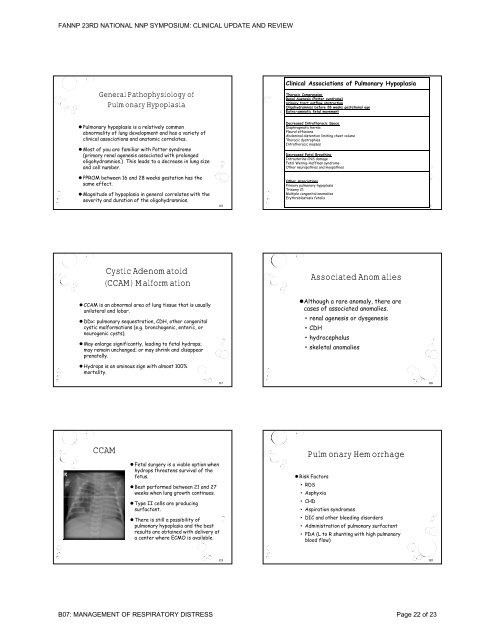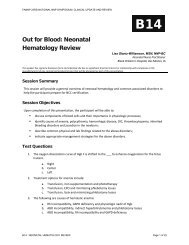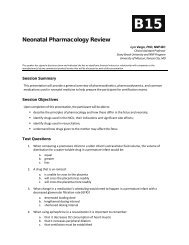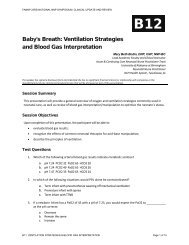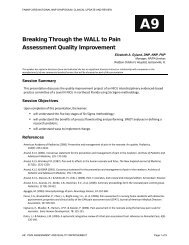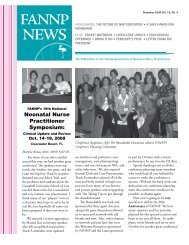Differential Diagnosis and Management of Respiratory ... - FANNP
Differential Diagnosis and Management of Respiratory ... - FANNP
Differential Diagnosis and Management of Respiratory ... - FANNP
You also want an ePaper? Increase the reach of your titles
YUMPU automatically turns print PDFs into web optimized ePapers that Google loves.
<strong>FANNP</strong> 23RD NATIONAL NNP SYMPOSIUM: CLINICAL UPDATE AND REVIEW<br />
General Pathophysiology <strong>of</strong><br />
Pulmonary Hypoplasia<br />
Clinical Associations <strong>of</strong> Pulmonary Hypoplasia<br />
Hypoplastic Lungs<br />
Thoracic Compression<br />
Renal Agenesis (Potter syndrome)<br />
Urinary tract outflow obstruction<br />
Oligohydramnios before 28 weeks gestational age<br />
Extra-amniotic fetal movement<br />
• Pulmonary hypoplasia is a relatively common<br />
abnormality <strong>of</strong> lung development <strong>and</strong> has a variety <strong>of</strong><br />
clinical associations <strong>and</strong> anatomic correlates.<br />
• Most <strong>of</strong> you are familiar with Potter syndrome<br />
(primary renal agenesis associated with prolonged<br />
oligohydramnios.) This leads to a decrease in lung size<br />
<strong>and</strong> cell number.<br />
Decreased Intrathoracic Space<br />
Diaphragmatic hernia<br />
Pleural effusions<br />
Abdominal distention limiting chest volume<br />
Thoracic dystrophies<br />
Intrathoracic masses<br />
Decreased Fetal Breathing<br />
Intrauterine CNS damage<br />
Fetal Wernig-H<strong>of</strong>fman syndrome<br />
Other neuropathies <strong>and</strong> myopathies<br />
• PPROM between 16 <strong>and</strong> 28 weeks gestation has the<br />
same effect.<br />
• Magnitude <strong>of</strong> hypoplasia in general correlates with the<br />
severity <strong>and</strong> duration <strong>of</strong> the oligohydramnios.<br />
115<br />
Other Associations<br />
Primary pulmonary hypoplasia<br />
Trisomy 21<br />
Multiple congenital anomalies<br />
Erythroblastosis fetalis<br />
1<br />
1<br />
Cystic Adenomatoid<br />
(CCAM) Malformation<br />
Associated Anomalies<br />
• CCAM is an abnormal area <strong>of</strong> lung tissue that is usually<br />
unilateral <strong>and</strong> lobar.<br />
• DDx: pulmonary sequestration, ti CDH, other congenital<br />
cystic malformations (e.g. bronchogenic, enteric, or<br />
neurogenic cysts).<br />
• May enlarge significantly, leading to fetal hydrops;<br />
may remain unchanged; or may shrink <strong>and</strong> disappear<br />
prenatally.<br />
•Although a rare anomaly, there are<br />
cases <strong>of</strong> associated anomalies.<br />
• renal agenesis or dysgenesis<br />
• CDH<br />
• hydrocephalus<br />
• skeletal anomalies<br />
• Hydrops is an ominous sign with almost 100%<br />
mortality.<br />
117<br />
118<br />
CCAM<br />
• Fetal surgery is a viable option when<br />
hydrops threatens survival <strong>of</strong> the<br />
fetus.<br />
• Best performed between 21 <strong>and</strong> 27<br />
weeks when lung growth continues.<br />
• Type II cells are producing<br />
surfactant.<br />
• There is still a possibility <strong>of</strong><br />
pulmonary hypoplasia <strong>and</strong> the best<br />
results are obtained with delivery at<br />
a center where ECMO is available.<br />
Pulmonary Hemorrhage<br />
• Risk Factors<br />
• RDS<br />
• Asphyxia<br />
• CHD<br />
• Aspiration syndromes<br />
• DIC <strong>and</strong> other bleeding disorders<br />
• Administration <strong>of</strong> pulmonary surfactant<br />
• PDA (L to R shunting with high pulmonary<br />
blood flow)<br />
119<br />
120<br />
B07: MANAGEMENT OF RESPIRATORY DISTRESS Page 22 <strong>of</strong> 23


